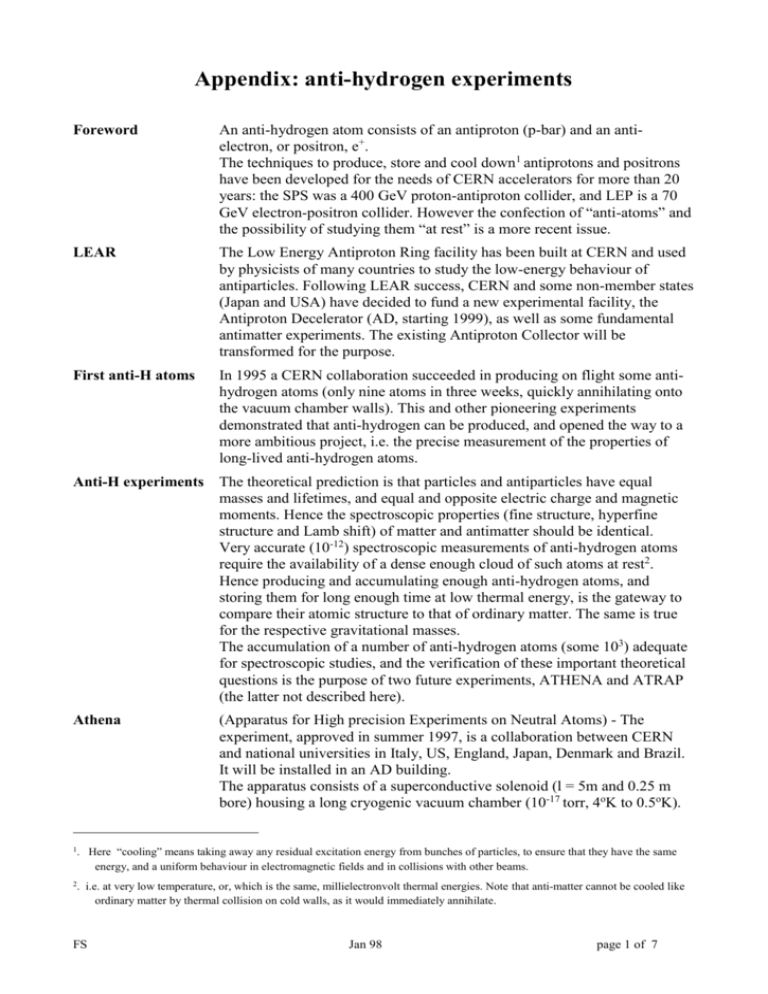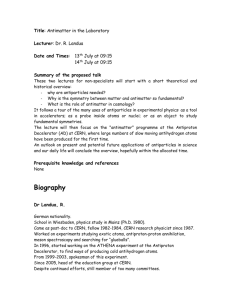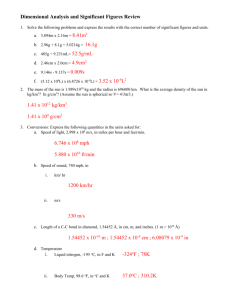Appendix: anti-hydrogen experiments
advertisement

Appendix: anti-hydrogen experiments Foreword An anti-hydrogen atom consists of an antiproton (p-bar) and an antielectron, or positron, e+. The techniques to produce, store and cool down1 antiprotons and positrons have been developed for the needs of CERN accelerators for more than 20 years: the SPS was a 400 GeV proton-antiproton collider, and LEP is a 70 GeV electron-positron collider. However the confection of “anti-atoms” and the possibility of studying them “at rest” is a more recent issue. LEAR The Low Energy Antiproton Ring facility has been built at CERN and used by physicists of many countries to study the low-energy behaviour of antiparticles. Following LEAR success, CERN and some non-member states (Japan and USA) have decided to fund a new experimental facility, the Antiproton Decelerator (AD, starting 1999), as well as some fundamental antimatter experiments. The existing Antiproton Collector will be transformed for the purpose. First anti-H atoms In 1995 a CERN collaboration succeeded in producing on flight some antihydrogen atoms (only nine atoms in three weeks, quickly annihilating onto the vacuum chamber walls). This and other pioneering experiments demonstrated that anti-hydrogen can be produced, and opened the way to a more ambitious project, i.e. the precise measurement of the properties of long-lived anti-hydrogen atoms. Anti-H experiments The theoretical prediction is that particles and antiparticles have equal masses and lifetimes, and equal and opposite electric charge and magnetic moments. Hence the spectroscopic properties (fine structure, hyperfine structure and Lamb shift) of matter and antimatter should be identical. Very accurate (10-12) spectroscopic measurements of anti-hydrogen atoms require the availability of a dense enough cloud of such atoms at rest2. Hence producing and accumulating enough anti-hydrogen atoms, and storing them for long enough time at low thermal energy, is the gateway to compare their atomic structure to that of ordinary matter. The same is true for the respective gravitational masses. The accumulation of a number of anti-hydrogen atoms (some 103) adequate for spectroscopic studies, and the verification of these important theoretical questions is the purpose of two future experiments, ATHENA and ATRAP (the latter not described here). Athena 1. 2. (Apparatus for High precision Experiments on Neutral Atoms) - The experiment, approved in summer 1997, is a collaboration between CERN and national universities in Italy, US, England, Japan, Denmark and Brazil. It will be installed in an AD building. The apparatus consists of a superconductive solenoid (l = 5m and 0.25 m bore) housing a long cryogenic vacuum chamber (10-17 torr, 4oK to 0.5oK). Here “cooling” means taking away any residual excitation energy from bunches of particles, to ensure that they have the same energy, and a uniform behaviour in electromagnetic fields and in collisions with other beams. i.e. at very low temperature, or, which is the same, millielectronvolt thermal energies. Note that anti-matter cannot be cooled like ordinary matter by thermal collision on cold walls, as it would immediately annihilate. FS Jan 98 page 1 of 7 Within the vacuum chamber, two Penning traps (electromagnetic field configurations which constitute a potential well for particles) will be used to concentrate and cool down antiprotons from the AD and positrons from an external source (techniques similar to those used at LEAR). The antiproton and positron traps surround a central recombination (antihydrogen) trap, where non charged atoms are formed and trapped by making their magnetic momenta interact with a magnetic gradient supplied by quadrupole coils. The goal is to merge there the antiproton and positron clouds, while preserving their low temperatures and high densities, to produce and store about 1000 low energy anti-hydrogen atoms. By carefully avoiding the contact of anti-particles with normal matter (i.e. any part of the apparatus), the annihilation rate of anti-hydrogen should be as low as a few atoms/hour. Two phases Strange though, free antiprotons and positrons do not recombine spontaneously to form anti-hydrogen atoms. The study and stimulation of the various recombination mechanisms is an experiment in itself. Thus the initial focus (phase 1) of the ATHENA experiment is on the production and storage of anti-hydrogen atoms at very low energies. A detector will be used to discriminate and count the annihilation of antihydrogen atoms (onto the detector walls), as compared to the annihilation of individual antiprotons and positrons. The second phase will include accurate spectroscopic measurements on antihydrogen atoms, by stimulating them with a laser source, and comparing the results with normal H atoms. Technology summary The experiment will use a blend of advanced techniques: - it will accumulate 107 antiprotons from the Antiproton Decelerator in a magnetostatic trap, cooling them down in a cloud of 109 electron at 0.5 oK. - it will similarly accumulate and cool down 108 positrons. - it will merge antiproton/positron high density clouds to form 1000 antihydrogen atoms, to be stored for hours at 0.5 oK. - Ultra-high vacuum (10-17 torr). - Fast vacuum valves. - Ultra-thin vacuum diaphragms. - Step-down low temperature systems (4 oK to 0.5 oK). - Radio Frequency and Nuclear Magnetic Resonance excitation techniques. - Laser beams for stimulated recombination, laser cooling, and spectroscopy. The detector The anti-hydrogen trap is surrounded by a detector which includes four stacks of silicon pad detectors - each layer with 128 pads of 1.25x2,56 mm2 connected to a 128 channel S&H preamplifier, read out serially at 5MHz. Fifteen such preamplifiers are daisy-chained and read out serially in 400sec into a CAEN ADC with 2048 channels memory depth. The ADC also performs pedestal subtraction and zero suppression, making the data ready for the memory of the DAQ processor. The detector is completed by an electromagnetic calorimeter, made of four blocks of CsI crystals read-out by special photodiodes. The read-out electronics attached to the detector must be maintained at a higher temperature (70oK) in a separate enclosure, in order to be usable. The goal of the detector for phase 1 is to discriminate and count the annihilation of anti-hydrogen atoms, to reconstruct the annihilation vertex FS Jan 98 page 2 of 7 with good resolution and to provide high burst capabilities to study the evolution in time of the recombination process. FS Jan 98 page 3 of 7








